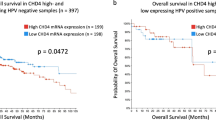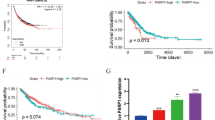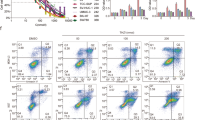Abstract
Purpose
Cisplatin can cause a variety of DNA crosslink lesions including intra-strand and inter-strand crosslinks (ICLs), which are associated with the sensitivity of cancer cells to cisplatin. Here, we aimed to assess the contribution of the Fanconi anemia (FA), homologous recombination (HR) and nucleotide excision repair (NER) pathways to cisplatin resistance in non-small cell lung cancer (NSCLC)-derived cells.
Methods
The expression of FA, HR and NER pathway-associated genes was assessed by RT-qPCR and Western blotting. siRNAs were used to knock down the expression of these genes. CCK-8 and flow cytometry assays were used to assess the viability and apoptotic rate of NSCLC-derived cells, respectively. Immunofluorescence and alkaline comet assays were used to assess the repair of ICLs.
Results
We found that acquired cisplatin-resistant NSCLC-derived A549/DR cells exhibited markedly enhanced FA and HR repair pathway capacities compared to its parental A549 cells and another independent NSCLC-derived cell line, Calu-1, which possesses a moderate innate resistance to cisplatin. siRNA-mediated silencing of the FA-associated genes FANCL and RAD18 and the HR-associated genes BRCA1 and BRCA2 significantly potentiated the sensitivity of A549/DR cells to cisplatin compared to A549 and Calu-1 cells, suggesting that the acquired cisplatin resistance in A549/DR cells may be attributed to enhanced FA and HR pathway capacities responsible for ICL repair. Although we found that expression knockdown of the NER-associated genes XPA and ERCC1 sensitized the three NSCLC-derived cell lines to cisplatin, the sensitization effect was more significant in Calu-1 cells than in A549 and A549/DR cells, implying that the innate cisplatin resistance in Calu-1 cells may result from an increased NER activity.
Conclusions
Our results indicate that the functional status of DNA repair pathways determine the sensitivity of NSCLC cells to cisplatin. Direct targeting of the pathway that is involved in cisplatin resistance may be an effective strategy to surmount cisplatin resistance in NSCLC.






Similar content being viewed by others
References
C. Zeng, W. Fan, X. Zhang, RRMI expression is associated with the outcome of gemcitabine-based treatment of non-small cell lung cancer patients – a short report. Cell. Oncol. 38, 319–325 (2015)
E. Prodromaki, A. Korpetinou, E. Giannopoulou, E. Vlotinou, M. Chatziathanasiadou, N. I. Papachristou, C. D. Scopa, H. Papadaki, H. P. Kalofonos, D. J. Papachristou, Expression of the microRNA regulators Drosha, Dicer and Ago2 in non-small cell lung carcinoma. Cell. Oncol. 38, 307–317 (2015)
Z. B. Cincin, M. Unlu, B. Kiran, E. S. Bireller, Y. Baran, B. Cakmakoglu, Anti-proliferative, apoptotic and signal transduction effects of hesperidin in non-small cell lung cancer cells. Cell. Oncol. 38, 195–204 (2015)
S. N. Bichev, D. M. Marinova, Y. G. Slavova, A. S. Savov, Epidermal growth factor receptor mutations in east European non-small cell lung cancer patients. Cell. Oncol. 38, 145–153 (2015)
J. Cadranel, G. Zalcman, L. Sequist, Genetic profiling and epidermal growth factor receptor-directed therapy in nonsmall cell lung cancer. Eur. Respir. J. 37, 183–193 (2011)
M.A. Socinski, T. Evans, S. Gellinger, T.A. Hensing, L.V.D. Sequisct, B. Ireland, T.E. Stinchcombe, Treatment of stage VI non-small cell lung cancer: diagnosis and management of lung cancer 3rd ed: American College of Chest Physicians Evidence-Based Clinical Practice Guidelines. Chest 143 (suppl.), e341s-e368s (2013)
I. A. Voutsadakis, The chemosensitivity of testicular germ cell tumors. Cell. Oncol. 37, 79–94 (2014)
L. Galluzzi, L. Senovilla, I. Vitale, J. Michels, I. Martins, O. Kepp, M. Castedo, G. kroemer, Molecular mechanisms of cisplatin resistance. Oncogene 31, 1869–1883 (2012)
Z. H. Siddik, Cisplatin: mode of cytotoxic action and molecular basis of resistance. Oncogene 22, 7265–7279 (2003)
X. Li, W. D. Heyer, Homologous recombination in DNA repair and DNA damage tolerance. Cell Res. 18, 99–113 (2008)
D. Branzei, M. Foiani, Maintaining genome stability to the replication fork. Nat. Rev. Mol. Cell Biol. 11, 208–219 (2010)
W. L. de Laat, N. G. J. Jaspers, J. H. J. Hoeijmakers, Molecular mechanism of nucleotide excision repair. Genes Dev. 13, 768–785 (1999)
Y. Jung, S. J. Lippard, Direct cellular responses to platinum-induced DNA damage. Chem. Rev. 107, 1387–1407 (2007)
N. Bhagwat, A. L. Olsen, A. T. Wang, K. Hanada, P. Stuchert, R. Kanaar, A. D’Andrea, L. J. Niedernhofer, P. J. McHugh, XPF-ERCC1 participates in the Fanconi anemia pathway of cross-link repair. Mol. Cell. Biol. 29, 6427–6437 (2009)
M. Räschle, P. Knipscheer, M. Enoiu, T. Anggelou, J. Sun, J. D. Griffith, T. E. Ellenberger, O. D. Schärer, J. C. Walter, Mechanism of replication-coupled DNA interstrand crosslink repair. Cell 134, 969–980 (2008)
Y. Kee, A. D. D’Andrea, Expanded roles of the Fanconi anemia pathway in preserving genomic stability. Genes Dev. 24, 1680–1694 (2010)
H. Kim, A.D. D’Andrea, Regulation of DNA cross-link repair by the Fanconi anemia/BRCA pathway. Genes Dev. 26, 1393–1408 (2012)
S. J. Araujo, F. Tirode, F. Coin, H. Pospiech, J. E. Syvaoja, M. Stucki, U. Hubscher, J. M. Egly, R. D. Wood, Nucleotide excision repair of DNA with recombinant human proteins: definition of the minimal set of factors: active forms of TFIIH, and modulation by CAK. Genes Dev. 14, 349–359 (2000)
J. Michl, J. Zimmer, M. Tarsounas, Interplay between fanconi anemia and homologous recombination pathways in genome integrity. EMBO J. 35, 909–923 (2016)
J. Huang, M. S. Y. Huen, H. Kim, C. C. Y. Leung, J. N. M. Glover, X. Yu, J. Chen, RAD18 transmits DNA damage signaling to elicit homologous recombination repair. Nat. Cell Biol. 11, 592–603 (2009)
S. A. Williams, S. Longerich, P. Sung, C. Vaziri, G. M. Kupfer, The E3 ubiquitin ligase RAD18 regulates ubiquitylation and chromation loading of FANCD2 and FANCI. Blood 11, 5078–5087 (2011)
M.A. Cohn, P. Kowal, K. Yang, W. Haas, T.T. Huang, S.P. Gggi, A.D. D’Andrea, A UAF1- Containing multisubunit protein. Mol. Cell 28, 786–789 (2007)
R. Roy, J. Chun, S. N. Powell, BRCA1 and BRCA2: different role in a common pathway of genome protection. Nat. Rev. Cancer 12, 68–78 (2012)
M. E. Mognhan, A. J. Pierce, M. Jasin, BRCA2 is required for homology-directed repair of chromosomal breaks. Mol. Cell 7, 263–272 (2001)
Y. Qing, M. Yamazoe, K. Hirota, D. Dejsuphong, W. Sakai, K. N. Yamamoto, D. K. Bishop, X. Wu, S. Takeda, The epistatic relationship between BRCA2 and the other RAD51 mediators in homologous recombination. PLoS Genet. 7, e1002148 (2011)
J. San Filippo, P. Sung, H. Klein, Mechanism of eukaryotic homologous recombination. Annu. Rev. Biochem. 77, 229–257 (2008)
D. T. Long, M. Raschle, V. Joukov, J. C. Waeter, Mechanism of RAD51-dependent DNA interstrand cross-link repair. Science 333, 84–87 (2011)
M. Yamazoe, E. Sonoda, H. Hochegger, S. Takeda, Reverse genetic studies of the DNA damage response in the chicken B lymphocyte cells DT40. DNA Repair 3, 1175–1185 (2004)
K. Kurkitt, M. Ljungman, Phenylbutyrate interferes with the Fanconi anemia and BRCA pathway and sensitizes head and neck cancer cells to cisplatin. Mol. Cancer 7, 24 (2008)
J. Chen, T. S. Dexheimer, Y. Ai, Q. Liang, M. A. Villamil, J. Inglese, D. J. Maloney, A. Jadhav, A. Simeonov, Z. Zhuang, Selective and cell-active inhibitors of the USP1/UAF1 deubiqitinase complex reverse cispcatin resistance in non-small cell lung cancer cells. Chem. Biol. 18, 1390–1400 (2011)
D. Chirnomas, T. Taniguchi, M. dela Vega, A. P. Vaidya, M. Vasserman, A.-R. Hartman, R. Kennedy, J. Mahoney, M. V. Seiden, A. D. D’Andrea, Chemosensitization to cisplatin by inhibitors of the Fanconi anemia BRCA pathway. Mol. Cancer Ther. 5, 952–961 (2006)
W. Duan, L. Gao, B. Aguila, A. Kalvala, G. A. Otterson, M. A. Villalona-Calero, Fanconi anemia repair pathway dysfunction, a potential therapeutic target in lung cancer. Front. Oncol. 4, 368 (2014)
S. Arora, A. Kothandapani, K. Tillison, V. Kalman-Maltese, S. M. Patrick, Downregulation of XPE-ERCC1 enhance cisplatin efficacy in cancer cells. DNA Repair 9, 745–753 (2010)
P. Chen, J. Li, H.-G. Jiang, T. Lan, Y.-C. Chen, Curcumin reverses cisplatin resistance in cisplatin-resistant lung cancer cells by inhibiting FA/BRCA pathway. Tumor Biol. 36, 3591–3599 (2015)
C.-H. Dai, J. Li, P. Chen, H.-G. Jiang, M. Wu, Y.-C. Chen, RNA interferences targeting the Fanconi anemia/BRCA pathway upstream genes reverse cisplatin resistance in drug-resistance lung cancer cells. J. Biomed. Sci. 22, 77 (2015)
A. Rothfuss, M. Grompe, Repair kinetics of genomic interstrand DNA cross-links: evidence for DNA double strand break-dependent activation of the Fanconi anemia/BRCA pathway. Mol. Cell. Biol. 24, 123–134 (2004)
F. Cavallo, G. Graziani, C. Antinozzi, D.R. Feldman, J. Houldswoth, G.J. Bosl, R.S. Chaganti, M.E. Moynahan, M. Jasin, M. Barchi, Reduced proficiency in homologous recombination underlies the high sensitivity of embryonal carcinoma testicular germ cell tumors to cisplatin and poly (ADP-ribose) polymerase inhibition. PLoS One 7, e51563 (2012)
C. Plasencia, E. Martinez-Balibrea, A. Martinez-Cardus, D. I. Quinn, A. Abad, N. Neamati, Expression analysis of genes involved in oxaliplatin response and development of oxaliplatin-resistant HT 29 colon cancer cells. Int. J. Oncol. 29, 225–235 (2006)
P. H. Clingen, J. Y. Wu, J. Miller, N. Mistry, F. Chin, P. .Wynne, K. M. Prise, J. A. Hartley, Histone H2AX phosphorylation as a molecular pharmacological marker for DNA interstread crosslink cancer chemotherapy. Biochem. Pharmacol. 76, 19–29 (2008)
M. Huang, A. D. D’ Andrea, A new nuclease member of the FAN club. Nat. Struct. Mol. Biol. 17, 926–928 (2010)
A. Ciccia, N. McDonal, S. C. West, Structural and functional relationships of the XPE/Mus 81 family of proteins. Annu. Rev. Biochem. 77, 259–287 (2008)
M. R. Hodskinson, J. Silhan, G. P. Crossan, J. I. Garaycoe-chea, S. Mukherjee, C. M. Johnson, O. D. Scharer, K. J. Patel, Mouse SLX4 is a tumor suppressor that stimulates the activity of the nuclease XPE-ERCC1 in DNA crosslink repair. Mol. Cell 54, 472–484 (2014)
M. Selvakumaran, D. A. Pisarcik, R. Bao, A. T. Yeung, T. C. Hamilton, Enhanced cisplatin cytotoxicity by disturbing the nucleotide excision repair pathway in ovarian cancer cell lines. Cancer Res. 63, 1311–1316 (2003)
X. Wu, W. Fan, S. Xu, Y. Zhou, Sensitization to the cytotoxicity of cisplatin by transfection with nucleotide excision repair gene xeroderma pigmentosum group a antisense RNA in human lung adenocarcinoma cell. Clin. Cancer Res. 9, 5874–5879 (2003)
B. Orelli, T. B. McClendon, O. V. Tsodikov, T. Ellenberger, L. J. Miedernhofer, O. D. Scharer, The XPA-binding domain of ERCC1 is required for nucleotide excision repair but not other DNA repair pathway. J. Biol. Chem. 28, 3705–3712 (2010)
M. Cummings, K. Higginbotton, C. J. McGurk, O. G. Wong, B. Koberle, R. T. Oliver, J. R. Masters, XPA versus ERCC1 as chemosensitising agents to cisplatin and mitomycin C in prostate cancer cells: role of ERCC1 in homologous recombination repair. Biochem. Pharmacol. 72, 166–175 (2006)
L. J. Niedernhofer, H. Odijk, M. Budzowska, E. van Drumen, A. Maas, A. F. Theil, J. de Wit, N. G. Jasper, H. B. Beverloo, J. H. Hoeijmakers, R. Kanaar, The structure-specific endonuclease Ercc-Xpf is required to resolve DNA interstrand cross-link-induced double breaks. Mol. Cell. Biol. 24, 5776–5787 (2004)
S. Usanova, A. Piee-Staffa, U. Sied, J. Thomale, A. Schneider, B. Kaina, B. Koberle, Cisplatin sensitivity of testis tumour cells is due to deficiency in interstrand-crasslink repair and low ERCC1-XPE expression. Mol. Cancer 9, 248 (2010)
Y. Huang, J. W. C. Leung, M. Lowery, N. Matsushita, Y. Wang, X. Shen, D. Huong, M. Takata, J. Chen, L. Li, Modularized functions of the Fanconi anemia core complex. Cell Rep. 7, 1–9 (2014)
Author information
Authors and Affiliations
Corresponding author
Ethics declarations
Competing interests
The authors declare that no competing interest exist.
Electronic supplementary material
Supplementary Fig. 1
The validation of siRNAs used in this study. Representative Western blotting showing FANCL, RAD18, BRCA1, BRCA2, XPA and ERCC1 expression in A549/DR cells. Cells were transfected with the indicated siRNAs separately for 48 h. Whole cell lysates were prepared and subjected to Western blotting for detecting the protein expressions of these factors. (GIF 81 kb)
Supplementary Fig. 2
The expression of cleaved caspase-3 and cleaved PARP were elevated in A549/DR cells after depletion of the FA and HR factors. (a) A549/DR cells were treated with 10 μM cisplatin for 4 h following transfection with non-targeting control siRNA (NC), siRNAs against FANCL, RAD18, BRCA1, BRCA2, XPA and ERCC1. Then cells were harvested and subjected to Western blotting with specific antibodies as indicated. (b) The relative expression levels of cleaved caspase-3 and cleaved PARP protein were quantified. (GIF 298 kb)
ESM 3
(DOC 39 kb)
ESM 4
(DOC 37 kb)
Rights and permissions
About this article
Cite this article
Chen, P., Li, J., Chen, YC. et al. The functional status of DNA repair pathways determines the sensitization effect to cisplatin in non-small cell lung cancer cells. Cell Oncol. 39, 511–522 (2016). https://doi.org/10.1007/s13402-016-0291-7
Accepted:
Published:
Issue Date:
DOI: https://doi.org/10.1007/s13402-016-0291-7




